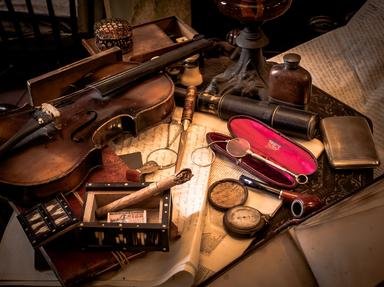Quiz Answer Key and Fun Facts
1. The subtitle for Part I of 'A Study in Scarlet' is 'Being a reprint from the reminiscences of JOHN H. WATSON, M.D., late of the Army Medical Department'. The story starts with a brief recounting of Dr. Watson's recent experiences and his first meeting with Holmes. Why does Watson's friend Stamford introduce him to Holmes?
2. As Holmes and Watson start to discuss whether or not it will be a good idea to enter into their proposed enterprise, each one mentions some of the possible obstacles to a harmonious relationship. Which of these potential sources of friction do they discover they share?
3. In the early part of his journal, Watson records that he is intrigued by the stream of visitors received by Holmes - his friends seem to come from a wide range of backgrounds! Eventually this is explained when Holmes divulges the nature of his occupation, as a professional consulting detective. Shortly thereafter, Holmes receives a note asking for his assistance in the solution of an apparent murder in an empty house at 3, Lauriston Gardens, off the Brixton Road. Who sent this message?
4. Inside the house, there is a lot of blood, although the dead man does not seem to have sustained any injury. What letters are written on the wall in blood, in a dark corner that was overlooked during the first investigation of the scene?
5. After the discovery of the message, Holmes proceeds to conduct a detailed examination of the room. This is the first time we see him using an investigative instrument that is indelibly associated with him. What aid to careful examination of the scene does he pull out of his pocket?
6. Inspector Gregson arrives in triumph to tell Holmes that he has made an arrest in the case. Whom has he taken into custody?
7. When Holmes is told that a book, a pipe, a box containing two pills and a telegram saying "J. H. is in Europe" were found at the scene of the second murder, he states that all is clear, and proceeds to make a demonstration using which of the items?
8. Part II of 'A Study in Scarlet' involves a flashback to fill in the story behind the current murders. In what country is the majority of this flashback set?
9. When Wiggins arrives and says he has a cab waiting downstairs, Holmes sends him down to ask the cabman to come up and collect some luggage. Of what group, seen in several Sherlock Holmes stories, is Wiggins the leader?
10. Is Jefferson Hope convicted of the murders he admits to having committed in the cause of justice?
Source: Author
looney_tunes
This quiz was reviewed by FunTrivia editor
agony before going online.
Any errors found in FunTrivia content are routinely corrected through our feedback system.

